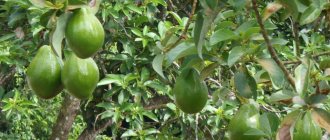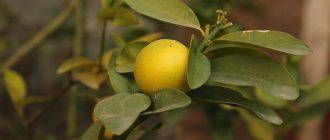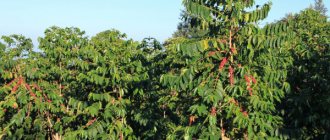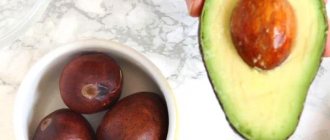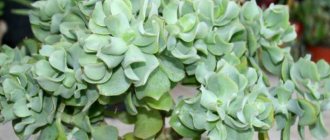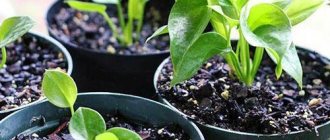- October 13, 2018
- Trees and shrubs
- Ksenia Yedikhanova
Avocados are known and loved by many, this is due to the unusual taste and high nutritional value of the fruit. Large green fruits can be purchased in almost any supermarket, but few people know how and where the avocado tree grows. Is it possible to grow an exotic crop yourself?
Appearance
What does an avocado tree look like? The plant is an evergreen tree that can reach a height of 6-18 m. The tree has ovate leaves with pointed tips, about 10-20 cm long and 2-12 cm wide, in a dark green hue. The flowers of the plant are unsightly, yellow-green in color, collected in small inflorescences in the form of umbrellas.
The avocado fruit is a green drupe with a thick, dark green skin. Its flesh is also green in color, has a slightly sweetish taste and a creamy-buttery consistency. The size of avocado fruits varies from 5 to 15 cm, depending on the degree of ripeness and variety.
The avocado tree can be of three varieties:
- West Indian - suitable for growing in tropical climates with high humidity.
- Guatemalan is a hardy species that grows in subtropical mountainous areas.
- Mexican is the most common variety due to its resistance to slight low temperatures, which other varieties cannot boast of.
Due to different varieties of culture, avocados from different countries may have slightly different appearance and taste.
Where does the avocado tree grow?
In many countries of the world, avocado is considered a plant close to laurel. It was cultivated by the ancient Greeks. The tree is native to North America.
Large-scale cultivation began in Israel, so this country can be considered a second homeland.
In nature, there are avocados with fruits of the following shades:
- yellowish-green;
- dark green;
- violet-reddish;
- deep purple.
The avocado tree grows well in different types of soil. But most of all it prefers to grow in areas with red clay or sand. The plant also responds well to limestone substrates.
The fruit is most cultivated in the Philippines, America, Asia, Australia, and Peru. In our country, only varieties of the Mexican group can be grown in open ground.
Purchase of planting material
You can try growing an avocado tree at home. To do this, you should take care of good planting material - a seed. It must be removed from ripe fruit purchased in a store. You need to choose the right avocado in order for the seed to germinate. For these purposes, only ripe fruits should be used. You can check ripeness in the following way: lightly squeeze the avocado with your palms, the fruit should take its previous shape after that. If you can’t buy ripe fruit, don’t despair, because it can always ripen at home on the windowsill.
After purchasing an avocado, the fruit itself can be eaten, because only the seed has value for germination. You need to remove it carefully so as not to damage its peel.
Planting methods
At home, an avocado tree can be grown in three ways:
- The seed is planted in loose soil with the blunt end down. It is important that the sharp end rises slightly above the surface of the ground. It is necessary to water the seedlings once every 7 days with clean water. This method is the simplest, but you will have to wait a long time for the first shoots, since the roots need to break through the hard crust of the seed.
- You need to punch three holes in the pit. After this, it is placed in water so that the holes are above the surface of the liquid. It remains in this state until germination, after which it can be placed in the ground.
- The last method involves completely clearing the seed from its shell. After this, it is placed in water until roots appear. This method is not only the fastest, but also the most interesting, since it becomes possible to observe the formation of the root system.
Regardless of the chosen method of planting an avocado seed, seedlings appear in 90% of cases, which is considered a fairly high figure.
Pest Control
- Insects . The yellow color and shedding of leaves can be caused not only by a violation of the temperature and watering regime, but also by parasitic infestation. Frequent culprits: spider mites or actively reproducing scale insects. They quickly lead a once healthy plant to death. Medicines containing avermecatins are effective against ticks. And wiping the leaves with a soap solution will help against scale insects.
- Fungi . In addition to powdery mildew, avocados are attacked by late blight. In this case, it will not be possible to cure the tree. The roots and bark are massively affected. Unfortunately, we have to get rid of the entire plant.
Growing in the ground
After the avocado tree sprouts from the seed, you can begin planting it in the ground. It is recommended to use universal soil for indoor plants, as it has a sufficient amount of nutrients and a loose structure. The soil must be well drained so as not to retain excess moisture, which is detrimental to the roots.
Experienced gardeners suggest adhering to the following planting system:
- drainage must be at least 2 cm in height;
- the bone goes two-thirds into the ground with the blunt end down;
- in this case, the sharp end must remain above the surface of the earth;
- After planting, it is recommended to water the plant with warm water once a week.
To ensure good rooted growth, it is necessary to fertilize the plant once every 2 weeks. In addition, avocado is a light-loving crop, so you should take care of good lighting in the place where the pot is located.
Pollination
Avogado blossom
Self-pollination . Avocados are capable of self-pollination, but the likelihood of waiting for fruit, if you only rely on this, is reduced to almost zero. Cross self-pollination . To do this, you need to plant several seeds in one pot. But, do not forget that this fruit plant, even under natural growing conditions, does not always bear fruit. Artificial pollination . It is made with a soft brush during the flowering period, when the pollen is ripe. Pollination is carried out up to 3 times during the month in the morning.
How to care?
How does an avocado grow? Despite the fact that countries with very warm climates are considered its homeland, growing avocados from seeds at home is possible. To do this, you need to know some nuances about caring for wood.
The optimal temperature for the plant is considered to be about +23 degrees, while in winter these indicators can be reduced to +10 degrees. If the temperature is below this mark, it will be detrimental to the young plant.
Flowering begins in the third year of the tree's life. In order to subsequently obtain fruits, it is necessary to have several plants so that they can be pollinated by insects. At the same time, it is recommended to expose the tree outside to direct sunlight in the spring and summer, as this has a beneficial effect on its growth and provides an opportunity for natural pollination.
Watering should also change throughout the year:
- in spring and summer, watering is required as the soil dries;
- in winter, after the soil dries, at least 2 days must pass before the next watering.
It is recommended to use settled water at room temperature. In this case, it is necessary to add fertilizer for citrus crops to the water and fertilize it with this composition once every 2 weeks in the spring and summer.
From the moment of flowering to the formation of fruits, about 6 months pass; during this time it is important to carefully care for the plant in order to obtain high-quality fruits.
An interesting option is to plant three seeds in one pot and then weave the trunks into a braid. At the same time, it is not recommended to make it tight; you need to leave space to compact the stems.
How to bring new life to an avocado seed
A correctly selected seed for germination will ensure almost 100 percent germination if you know how to plant an avocado correctly.
The simplest and most effective way to germinate an avocado is the so-called closed method of planting the seed directly into the ground.
Before planting, the seed must be thoroughly cleaned of pulp, rinsed under running water and dried. To plant in the ground, you need to prepare a small pot with drainage and a nutritious soil mixture for tropical plants.
The seed should be placed in a pot half filled with soil, with the tip facing up, then add soil, being sure not to cover the top of the pit by a few centimeters. After this, the pot of avocado should be placed in a warm and well-lit place (but not in the open sun) and watered generously.
Under the right conditions and regular watering as the soil dries out, the avocado sprout will sprout in approximately 3-4 weeks.
Treatment of diseases
When growing an avocado tree at home, you should beware of the same diseases that affect many other cultivated plants:
- Phytophthora is a fungal disease that over time destroys the root system. The disease can be identified by the sudden appearance of ulcers on the trunk and leaves of the tree. After detection, the affected plant should be set aside from others and the affected parts should be pruned.
- Spider mites appear when there is high humidity in the room where the avocado grows. It can be identified by yellowing leaves and their falling off. The diseased plant must be sprayed with a soap solution and the affected parts of the tree removed.
- Powdery mildew appears as a white coating on the leaves, causing them to curl. This disease can be controlled with fungicides.
In addition, the avocado tree at home is susceptible to the same pests that affect other indoor plants. These are scale insects, whiteflies, aphids, and mealybugs.
Frequent difficulties
- Leaves are falling . The most likely cause of the disease is excessive soil moisture or rotting of the root system. Solution: stop flooding the plant with large amounts of water. If a tree drops its top leaves, this indicates dryness and insufficient watering. Note to lovers of home gardening: you need to water not only the soil, but also moisten the leaves.
- The leaves are curling up . This is how avocados suffer from too cold air. A gradual increase in temperature to optimal levels can save the situation. Or perhaps the reason lies in the opposite: abnormal heat destroys the life of the plant. And it has to be properly eliminated.
- Mold plaque . Powdery mildew causes a downy coating on the foliage. Even if it disappears on its own over time, the plant needs treatment. Infected leaves are removed, the remaining ones are treated with manganese solution. It would be a good idea to update the top layer of soil.
Tree pruning
Although the avocado tree does not grow to its maximum size at home, it is necessary to periodically prune it. This way you can control its length and give it the desired shape. Trees that are not pruned have a minimum number of side shoots, grow exclusively in height and, as a result, have an unattractive appearance.
To form a beautiful crown, which can be seen in any photo of an avocado tree, pruning in a pot must be done every spring. In the first year of growth, it is important to shorten the tree after 7-8 leaves, and the side shoots after 5-6. In the future, annual pruning can increase the number of side shoots and control the height of the tree.
Possibility of fruiting avocados at home
Under natural conditions, this evergreen fruit plant grows up to 20 meters in height. When grown at home, its maximum height is fixed at 3 meters.
The ability to wait for fruiting 3 to 6 years after planting increases significantly if several avocado sprouts are adjacent to one pot.
Skeptics claim that only 5% of plants bear fruit at home, while optimists say that the likelihood of flowering and fruiting with proper care is extremely high.
In any case, a fruit-bearing avocado is a source of well-deserved pride for the owner.
Beneficial features
Despite the fact that growing a fruit-bearing avocado tree at home is quite difficult and time-consuming, the resulting fruit will undoubtedly delight you. In addition to the classic taste, they have the same beneficial properties as store-bought fruits:
- vitamins A and E;
- monosaturated fats;
- antioxidants;
- useful minerals.
Based on the totality of useful substances, avocado fruits are good in that they prevent diseases of the cardiovascular system, have a beneficial effect on the gastrointestinal tract, and are useful for diabetes and cataracts.
Despite its benefits, avocado, like most other fruits, is not hypoallergenic, so it can cause individual allergic reactions. For this reason, it is not recommended to give avocados to children under 14 years of age.
Avocado varieties
Hass
Peel: dark purple, rough to the touch.
Weight: 250-350 g. This avocado variety is grown all year round in Mexico, Spain, Canada and Brazil. It differs from other brethren in that the peel turns purple when ripe. The shade can be very dark, almost black. The pulp of the fruits of this species is distinguished by a delicate nutty taste, white in color with green or yellow streaks. Contains many essential oils that have a positive effect on the body. Contains:
- Microelements (improve the functioning of the digestive tract and accelerate metabolic processes).
- Mono-saturated acids (activate tissue regeneration).
- Vitamin D (normalizes the growth of the skeletal system and strengthens blood vessels).
Fuerte
Peel: green, thin and smooth to the touch. Weight: 200-400 g. This variety of avocado is quite famous; it is grown in South Africa, Peru and Israel. The culture bears fruit in the autumn-winter period. It is distinguished by its creamy, fatty pulp, snow-white color. The taste resembles sour cream or cream, with a sweet aftertaste. The seed inside is small in size, the fruit is pear-shaped.
Contains:
- Oleic acid (improves brain activity and lowers blood cholesterol levels).
- Phytosubstances (have a general strengthening effect on the body and destroy malignant cells).
- Carotenoids (help maintain youth at the cellular level).
Zutano
Peel: yellow-green, smooth to the touch. Weight: 300-420 g. Grown in Brazil and Mexico. It can be found on sale all year round, as it is grown in the Southern Hemisphere. The variety is considered one of the best. It has an elongated pear-shaped shape. It has soft, light green or creamy flesh with a light, watery flavor that is reminiscent of apple.
Contains:
- Macroelements (magnesium, which has a positive effect on the nervous system).
- Ascorbic acid (improves regenerative processes in tissues, increases the body's resistance to stress and disease).
Mexicola
Peel: dark purple. Weight: 70-100 g. This is a high-quality and frost-resistant avocado variety. Resistant to cold temperatures. The anise-flavored pulp is distinguished by its delicate, creamy texture with a rich mushroom or nutty flavor. They are grown in Russia, the Caucasus, and Central America.
Contains:
- Vitamin E (has a beneficial effect on hair and nail growth).
- Palmitic acid (it prevents the formation of cancer cells).
- Phosphorus (needed for healthy teeth, joints and internal organs).
Bacon
Peel: green. Weight: 200-250 g. This variety of avocado fruit is distinguished by its low fat content. The fruits are small, oval in shape. The pulp is pale green. Does not have a pronounced taste. Grown primarily in California.
Contains:
- Selenium (restores thyroid function, protects the body from damage).
- Iron (improves cholesterol metabolism and helps the immune system fight stress).
- Copper (participates in hematopoiesis and prevents the development of anemia).
Features of a home tree
A home-grown avocado has some differences from a naturally grown avocado:
- The height of a tree in nature can reach 18 m, while the height of a home avocado reaches a limit of 2 m. At the same time, it looks quite decorative and interesting.
- It takes a lot of time and effort to create the conditions in which a tree begins to bear fruit, so most often such a tree is used exclusively for decorative purposes.
- If all conditions are created for the plant to bear fruit, its fruits are slightly inferior in size and taste to the imported ones.
- Avocados purify the air, which is why they are popular among gardeners.
In general, growing an avocado does not present any particular difficulties if there is no goal to ensure its constant fruiting.
